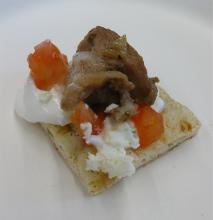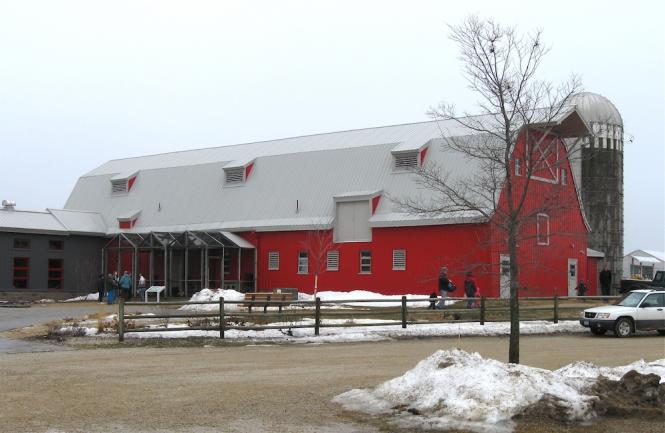The sheep were looking quite sheepish.
Last Saturday was Shearing Day Gale Woods Farm and though the animals in question were none too pleased, the children watching intently were delighted as the shearer wielded his clippers with gentle efficiency while piles of wool gathered at his feet. Later, the young visitors moved from the barn to the activity room, where staff and volunteers demonstrated how wool that just a short time before adorned the sheep was spun into yarn and woven into fabric. As parents and kids practiced "carding" (brushing the wool fibers) and made felted crafts to take home, others enjoyed a delicious sampling of farm-grown lamb, served on warm pita and topped with tomatoes and a refreshing yogurt sauce. 
Bringing Home the Farm
One simple way of bringing the farmstead into the homestead is through Gale Woods’ food, sourced from their own animals and crops, which are available through CSA shares or purchased directly at the farm. “Our vegetable shares are made up of pretty much everything you can grow in Minnesota,” Reese said, noting that in addition to popular seasonal items such as spring peas, summer tomatoes and autumn squash, they also grow less familiar produce such as mustard greens and celeriac. “We always provide recipes so people know what to do with them,” he added. “And some say, ‘You know, I don’t think my kids are going to eat that’.”
As if to encourage more awareness of food’s origins, Gale Woods CSAs are not delivered to drop-off points in the city; instead, shareholders pick up their bounty twice a week directly from the farm, where the produce is arranged farmers’ market style. “We have the vegetables set out and tell people how much they can take, giving them more options,” explained Reese. “They have a little bit more flexibility – they don’t have to take as much and feel bad about wasting any of it.”
To ensure that good food is never wasted, the farm maintains relationships with local food shelves. “Our closest one is Mound/Westonka Food Shelf, where we donate at least two shares a week, and sometimes even more, depending on the success of the season,” Reese said. Furthermore, non-shareholders can come to the farm during scheduled CSA pick-ups on Tuesdays and Thursdays to purchase the excess produce. In fact, it is now the only option for anyone interested in Gale Woods’ vegetables this year – the farm’s 70 CSA shares are wildly popular and sold out within three hours of becoming available in early March.
“Since everyone purchases the produce directly from the farm, we can talk about all the practices that we use,” Reese said, explaining that although Gale Woods Farm is not certified organic, it follows organic practices. The real value of organic labeling, he observed, is for consumers who buy their produce from retailers and may need another party to certify the organic practices of the sourcing farm. “At Gale Woods, people can really do their own certification – they can see exactly what we’re doing.”
In addition to vegetables, Gale Woods Farm also offers meat from their resident livestock -- beef, pork, lamb, chicken and eggs. Of these, only the beef is organic (although it does not officially carry that designation) as nearly 70 percent of the farm’s acreage is set aside for growing its own organic hay used to feed the cattle. The poultry, pigs and sheep are given conventional feed, but Reese points out that it is not exclusively so. “In the summertime, our egg-laying flock is out in the field, so they’re pasture-raised and getting some of their nutrition by scratching in the soil,” he explained. “We also have the sheep out pasturing during the growing season, getting an all-grass diet. And the pigs will actually be out in the woods because we cut about 10 acres of buckthorn and we’re hoping they’ll root out some of the roots.”
Playing and Learning with Food
The staff of Gale Woods Farm is eager to teach everyone who is interested about where and how their food is grown, and that includes the youngest visitors. A farm is a wondrous place for children but at Gale Woods, it’s more than just a petting zoo of barnyard animals. Program Coordinator Andi Anderson described the new food programs aimed at budding cooks: “We work with a nutritionist to help us develop recipes, so they’re nutrition-focused, but the concept is really to introduce kids to healthy, local food, and the idea of slow food.”
Called "Eat, Play and Grow," these weekly classes incorporate creative play and hands-on cookery to help make the early connections between food and farm. Developed for children aged 2 to 5 years and accompanied by an adult, the program is intentionally scheduled in the early evening so that it culminates with dinner. “The whole family focus is important to us,” said Anderson. “We feel that modeling that behavior of sitting down and eating together is so important.” An equal focus is on class themes through which activities and food complement the season: one event this past winter centered on high-energy foods, so the kids went sledding and snowshoeing, then returned to make granola bars and trail mixes. During warmer months, playtime may involve running through a hay maze or even doing chores in the barn, such as rounding up chickens and collecting eggs.
“As much as possible, we use food sourced from the farm. Sometimes, we have to supplement from local grocery stores,” Anderson explained. “But we’ve made a commitment to make sure that it’s organic and whenever possible, local.” She added that programs, such as a spring pizza-making class coinciding with the availability of garden herbs, are meant to connect food back to the farm. Inevitably, that connection may include explaining that the cute little piglet or lamb may some day become food. “We don’t go into detail, but we do talk about what the animal’s job is and what they’re here for,” Anderson acknowledged. “We try to emphasize how the animals are cared for and their health while they’re here, so that kids and families are making conscious choices about where their food is coming from.”
And the children are soaking it up. Anderson was pleased to relate how kids who return for other classes will often share stories about what they had for lunch at school and what was good or bad about it. The Eat, Play and Grow program has been so successful that there are plans to offer a lunchtime version in the fall. Furthermore, similar summer classes have been scheduled for young teens, who can participate in activities ranging from canoeing to rock wall climbing. Anderson hopes that they will take away even more than just newfound awareness of food and its origins. “My goal for that age group is that they can eventually do the food demos for farm events, to be more of a youth leader and teach other kids what they’ve learned.”
How about adults? Rest assured that fun times aren’t just for the kids – a wide variety of programs are offered at the Folk School to suit many interests. Reese points to classes ranging from maple syrup tapping to beekeeping and the increasingly popular backyard chicken raising, while Anderson says that more adult family-focused cooking classes will be offered. “This fall, we’re going to teach how to pack a healthy school lunch,” she noted, also mentioning next weekend’s "Cooking with Lamb" event and plans for a June grilling class, both taught by Chef Sean Jones of St. Paul College’s Culinary Arts program. And similar to Eat, Play and Grow is an early January event called Winter Sunrise, during which participants help with early morning farm chores, such as collecting eggs and grinding corn, then use the products of their labors to cook a fresh-from-the-farm breakfast for themselves.
Anderson is hoping to build more momentum for these programs. “I think our kitchen is something that people don’t anticipate us having because our cooking classes have not really taken off,” she admitted. “I have to wonder if some people think it’s only a farm and not a teaching kitchen. But we have it!” Anderson would like to spread awareness of the increasing variety of activities at Gale Woods Farm. “We’re very open to trying things as they relate to sustainable farming and local foods,” she said. “We have a set of programs but we’re also open to people’s suggestions and ideas for other programs.”
By offering visitors an opportunity to see firsthand how food is produced, to learn hands-on how to utilize natural resources such as sheep’s wool and maple syrup, and to provide healthy foods and a place to enjoy activities in the fresh air, Gale Woods Farm is dedicated to helping us form those tangible connections to our bodies, our environment, and our families.
As Tim Reese noted, all of this year’s CSAs have sold out, but the general public is welcome to purchase vegetables directly at Gale Woods Farm on Tuesdays and Thursdays from 3:00 to 6:00 p.m., beginning mid-June through October. Meat shares of lamb and pork are also available.
 Tracey Paska, a student at the University of Minnesota, is pursuing a self-designed degree in food studies, which combines coursework in anthropology, history and sociology as they pertain to the foods we eat. She was born in the Philippines, but now lives in the western suburbs of Minneapolis with her husband. When she's not composing research papers, she writes about the complex, confusing and fascinating connections between food, culture, and society on her blog Tangled Noodle. She also has contributed articles to the Minnesota Women's Press and hopes to make food writing her profession.
Tracey Paska, a student at the University of Minnesota, is pursuing a self-designed degree in food studies, which combines coursework in anthropology, history and sociology as they pertain to the foods we eat. She was born in the Philippines, but now lives in the western suburbs of Minneapolis with her husband. When she's not composing research papers, she writes about the complex, confusing and fascinating connections between food, culture, and society on her blog Tangled Noodle. She also has contributed articles to the Minnesota Women's Press and hopes to make food writing her profession.




